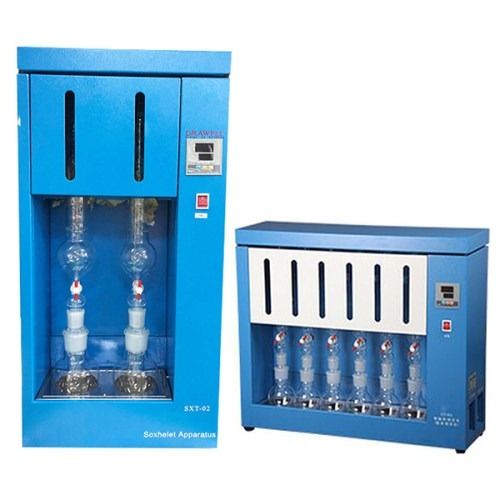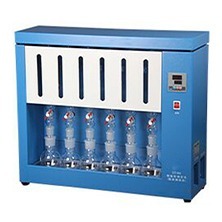Soxhlet extraction is a well-established extraction method that has been widely utilized in laboratories and the industry for extracting a wide range of chemicals from solid samples.

1. Follow the Soxhlet Extraction Steps
Soxhlet extraction is a continuous extraction process that includes cycling a solvent through a solid sample repeatedly in order to extract the desired chemical.
- Prepare the Soxhlet Extractor
Assemble the Soxhlet extractor by connecting the condenser to the Soxhlet flask and then connecting the syphon tube to the bottom of the Soxhlet flask. To prevent the solid material from escaping during the extraction, place a small piece of glass wool or filter paper inside the Soxhlet flask.
- Weigh the Solid Sample
Weigh an adequate amount of the extracted solid sample and insert it in the Soxhlet flask.
- Add the Solvent
Add enough solvent to the Soxhlet extractor’s round-bottom flask to completely cover the solid material. The solvent used is determined by the target chemical and its solubility qualities.
- Start the Extraction
Start heating the round-bottom flask with the Soxhlet extractor and a heating source. The solvent will boil and vaporize, and the vapors will rise into the Soxhlet flask, where the target component will be extracted from the solid sample.
- Continue the Extraction
Allow the extraction to run for several hours or overnight, depending on the sample type and desired extraction efficiency. The solvent will cycle forever through the solid sample, extracting the target chemical into the solvent.
- Collect the Extracted Solution
Once the extraction is complete, carefully remove the Soxhlet extractor from the heating source and separate the round-bottom flask with the extracted solution from the Soxhlet flask containing the solid sample. The extracted solution should be stored in a separate beaker or flask.

2. Remember the Efficiency Affecting Factors of Soxhlet Extraction
Several factors can influence the efficiency of Soxhlet extraction, which refers to the effectiveness of extracting target molecules from solid samples. Understanding these variables is critical for optimizing the Soxhlet extraction process and obtaining dependable and accurate results.
- Sample Characteristics
The nature and properties of the solid material being extracted can have a substantial impact on extraction efficiency. The pace and extent of extraction can be influenced by factors such as sample size, surface area, and composition. Smaller particle sizes and bigger surface areas offer more contact between the solid sample and the extraction solvent, resulting in higher extraction efficiency. To ensure efficient extraction, it is critical to choose a suitable sample size and appropriately prepare the sample.
- Solvent Selection
The extraction solvent selected is essential to the efficiency of Soxhlet extraction. The solvent should be polar and compatible with both the target chemicals and the solid material being extracted. To ensure good extraction and efficient evaporation and condensation during the extraction process, the solvent should also have a high boiling point. The proper solvent or solvent mixture must be chosen in order to achieve maximum extraction efficiency.
- Extraction Time and Temperature
The duration and temperature of the extraction process can have an effect on Soxhlet extraction efficiency. Longer extraction durations can result in larger extraction yields, but they can also cause heat-sensitive chemicals to degrade. To avoid deterioration or loss of volatile chemicals, the extraction temperature should be carefully managed. To maximize extraction efficiency, the optimal balance of extraction time and temperature must be found.
- Extraction Cycles
The number of extraction cycles, or the number of times the solvent is circulated through the sample, can also affect Soxhlet extraction efficiency. By allowing for more contact time between the sample and the solvent, increasing the number of extraction cycles may improve extraction efficiency. Too many cycles, on the other hand, may result in declining returns and increased solvent use. The ideal number of extraction cycles for each sample and chemical should be determined empirically.
- Type and Condition of the Extraction Thimble
The extraction efficiency might also be affected by the type and condition of the extraction thimble used in the Soxhlet extractor. The extraction rate and yield can be affected by the thimble’s material (such as glass, cellulose, or metal) and pore size. The extraction efficiency can also be affected by the thimble’s condition, such as cleanliness and integrity. Proper extraction thimble selection and preparation are critical concerns in Soxhlet extraction.
- Agitation and Reflux Rate
The pace at which the solvent is cycled through the sample, known as agitation or reflux rate, can have an effect on extraction efficiency. Proper agitation or reflux rate can promote sample-solvent interaction, resulting in improved extraction efficiency. However, excessive agitation or reflux rate may result in sample packing or channeling, reducing extraction efficiency.
- Solvent-to-sample Ratio
The solvent-to-sample ratio, which is the ratio of solvent volume to sample mass, can also affect extraction efficiency. Using an optimum solvent-to-sample ratio can guarantee that there is enough solvent for successful extraction without dilution. The ideal solvent-to-sample ratio will differ according to the sample type and chemical of interest and should be tested.
- Operator Skills and Experience
The operator’s competence and experience in setting up and operating the Soxhlet extraction process might also have an impact on extraction efficiency. Proper Soxhlet extractor assembly, careful control of extraction conditions, and attention to detail during the extraction process can all have an impact on extraction efficiency.

3. Take Safety Considerations During Soxhlet Extraction
Safety precautions can assist limit the dangers of Soxhlet extraction and ensure a safe working environment for all people participating in the process.
- Ventilation
To avoid the accumulation of potentially dangerous solvent vapors, Soxhlet extraction should be performed in a well-ventilated room or beneath a fume hood. Adequate ventilation serves to reduce the risk of inhaling solvents, which can be hazardous or even lethal.
- Personal Protective Equipment (PPE)
To prevent solvent contact and any splashes, personal protective equipment such as gloves, goggles, and a lab coat should be worn during Soxhlet extraction.
- Solvent Selection
The choice of solvent for Soxhlet extraction should be made with care. Some solvents are toxic, combustible, or dangerous, and their qualities must be thoroughly studied. Follow correct solvent handling, storage, and disposal practices.
- Heat Safety
Soxhlet extraction necessitates the heating of solvents, therefore proper care must be taken to avoid burns or fires. Wear heat-resistant gloves, make sure all electrical connections are secure, and use appropriate heating equipment with temperature controls.
- Equipment Handling
The safe handling and operation of Soxhlet extraction equipment is critical. Read the manufacturer’s instructions for the exact Soxhlet extractor you’re using and make sure it’s correctly constructed, operated, and maintained.
- Monitoring
Monitor the extraction process on a regular basis to ensure that it is proceeding safely and without incident. Monitor the condenser, boiling flask, and extraction thimble for any leaks, blockages, or other potential issues.
- Emergency Preparedness
Prepare for emergencies by keeping a spill kit, a fire extinguisher, an emergency eyewash, and a shower accessible. Know where to find safety equipment and how to respond to spills, fires, or accidents.
- Training and Supervision
Only skilled and experienced persons who are knowledgeable about the process’s dangers should execute Soxhlet extraction. To ensure safe and proper operation, novice users should be supervised by experienced operators.
- Proper Cleanup and Disposal
After finishing the Soxhlet extraction, dispose of the used solvents, extraction thimble, and other debris in accordance with local legislation and procedures. To avoid cross-contamination, properly clean the equipment.
Summary
Soxhlet extraction is a diverse process that necessitates correct knowledge, skills, and safety procedures in order to be safe and efficient.

